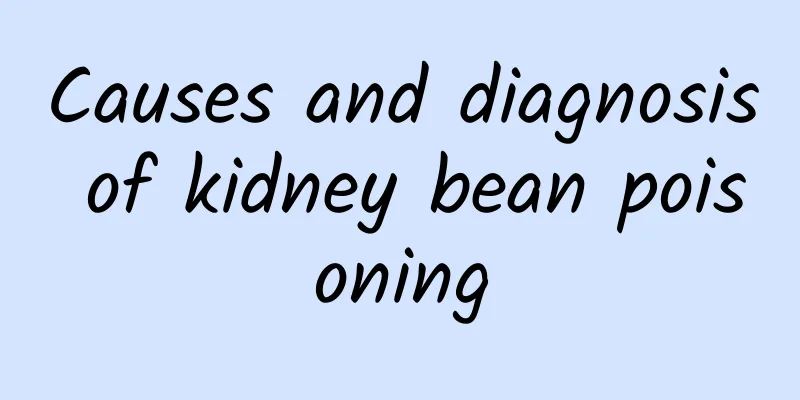Causes and diagnosis of kidney bean poisoning

|
What should we do if we get poisoned when eating kidney beans? Today, let me tell you what to do if you get poisoned by kidney beans. Kidney bean poisoningKidney beans, also known as kidney beans, green beans, sword beans, navy beans, stick beans, and plum beans, are mostly poisoned by eating fried or undercooked kidney beans, and usually occur in autumn. 【Toxicity Overview】The toxins that cause poisoning after eating kidney beans are still not very clear, so the mechanism of poisoning is still unclear. In the past, the toxic substances in kidney beans were generally called bean extracts. Later, some people believed that the poisoning was related to the hemolytic effect of saponins. In recent years, it is believed that the toxic component may be the coagulation effect of hemagglutinin. Some people also believe that saponins and hemagglutinins play a role in kidney bean poisoning, and that the two exist in different parts of fresh kidney beans, the former in the epidermis of the pods, and the latter in the beans. The toxic substances in kidney beans are easily soluble in water and are not resistant to high temperatures. They are non-toxic when cooked. Due to the different varieties and maturity of kidney beans, some are mainly pods, and some are mainly beans. Whether it is saponins or hemagglutinins, these two substances can cause poisoning. Saponins are a class of extremely complex compounds that are widely present in plants. After shaking, their aqueous solutions have persistent foam, so they are called saponins. Saponin is highly irritating to the digestive tract, can cause hemorrhagic inflammation, and has a dissolving effect on red blood cells. Heating at 100°C for more than 30 minutes can destroy the toxicity; beans contain hemagglutinin, which has a hemagglutinating effect. If kidney beans are left for too long, they can produce a large amount of nitrite, causing metahemoglobinosis. The acute median lethal dose of kidney beans for mice is about 19 grams/kg. 【Cause of poisoning】Kidney beans are a vegetable that people eat all year round. Kidney bean poisoning occurs all year round, but it is more common before and after frost. A large number of facts show that kidney bean poisoning is mainly related to improper cooking methods. For example, eating kidney bean buns, dumplings, pies, fried kidney beans over high heat, and various cold kidney beans are all likely to cause poisoning, but eating cooked stewed kidney beans has never caused poisoning. This is because the toxic substances contained in raw kidney beans can be destroyed by continuous high temperatures. If the toxins are not destroyed due to insufficient heating, they can cause poisoning after being eaten. All kidney beans that cause poisoning have a common feature, that is, "the color of the kidney beans has not completely changed, and they are hard and have a strong bean smell when chewed." 【Diagnosis points】(1) History of eating uncooked beans. (II) Clinical manifestations: 1. Short incubation period and rapid onset, which can occur within minutes after eating, and most cases last 2 to 4 hours. Short course of illness, usually recovering within 1 to 3 days. A few severe cases may develop hemolytic anemia. 2. Digestive system: The main symptoms are nausea, vomiting, abdominal pain, diarrhea, upper abdominal discomfort or stomach burning sensation and other symptoms of acute gastroenteritis (mostly watery stools, and vomiting blood in severe cases). 3. Nervous system: dizziness, headache, numbness of limbs, cold hands and feet, chest tightness, palpitations, cold sweats and back pain. Body temperature is mostly normal or accompanied by low fever. 【Treatment points】Usually, vomiting and diarrhea will heal quickly. For severe cases, sugar and saline solution and vitamin C can be intravenously dripped to correct water and salt imbalance and promote the excretion of poisons. The treatment principles are: (i) Eliminate poisons: induce vomiting, gastric lavage, infusion, diuresis. (ii) Symptomatic treatment: 1. Belladonna drugs can be used for gastroenteritis, and hemostatics can be used for vomiting blood. 2. In case of hemolysis, sodium bicarbonate can be used to alkalize urine, adrenal cortex hormones can be used in the early stage, and blood transfusion can be used if necessary. When there is coagulation phenomenon, low molecular weight dextran, heparin, etc. can be given. 【Precautions】The key to avoiding kidney bean poisoning is to stir-fry and cook thoroughly to destroy the toxins in them, and also be careful not to eat too much at one time. No matter what method is used, it is best to soak them in cold water or blanch them in boiling water before cooking to ensure that they are fully heated and cooked. Kidney beans are best stewed, and when stir-fried, the color of the beans should change completely, and they should be cooked inside and out, and there should be no bean smell when eating. 【Test method】There is currently no reliable method for testing for kidney bean poisoning. The following are methods that some scholars have explored in practice for reference. (I) Saponin qualitative test: 1. Foam reaction: weigh 1~5g of sample (be careful to remove the oil on the surface of the remaining food), add 10~50ml of water, boil, filter, take 5ml of filtrate and shake in a test tube. If there is persistent foam, heat it, and then divide the solution into two tubes, add 5% sodium hydroxide solution to one tube, and add 5% hydrochloric acid to the other tube to make it acidic. If foam occurs, it proves the presence of saponin. (I have doubts about the reliability of this method, which is prone to false positives. I have used raw cabbage as a control and a positive result appeared, so it cannot be used as a confirmation test) 2. Hemolysis reaction: weigh 1~5g of sample, add 10~50ml of saline and soak for several hours, shake, boil, filter, take 5ml of filtrate, add an equal amount of 2% defibrinated blood cell saline suspension, put it in a 37℃ incubator for 30 minutes, take it out and shake to observe the dissolution of blood cells. If the blood cells dissolve into a transparent state, saponin exists. (II) Hemagglutinin assay 1. Exclusion test: including negative analysis of various chemical toxins similar to the clinical manifestations of kidney bean poisoning; negative tests for enterotoxin-producing bacterial strains and toxins such as Staphylococcus. 2. Hemagglutinin assay: 5g of the remaining kidney beans were ground, soaked in 50ml of normal saline for 5 hours, centrifuged to obtain the supernatant and filtered, and the filtrate was used to make 4 dilutions, 0.5ml per tube, and 1 drop of 2% human blood cell suspension (washed 3 times by centrifugation) was added respectively, shaken well and placed in a 37℃ incubator for 3 hours to determine the results, and raw and cooked kidney beans were used as negative and positive control tests. |
<<: Open-air tomato planting technology
>>: Field management of broad beans
Recommend
The role and efficacy of aloe vera external application The medicinal value of aloe vera external application
In the eyes of many people, aloe vera is a good p...
Qi-tonifying and blood-tonifying porridge
Introduction to Qi and Blood Replenishing Porridg...
What are the benefits of salt water foot bath?
Edible salt is an essential condiment in the fami...
The benefits of eating snow vegetables
Snow vegetable, also known as Chinese mustard gre...
How to clean cherries
May is the season for cherry to ripen. Cherries a...
What is the difference between kiwi fruit and kiwi fruit?
Many people think that kiwi and kiwi fruit are th...
How is Homework Tutoring? Homework Tutoring Reviews and Website Information
What is Homework Help? Homework Help is a US websi...
Comparison of Hyacinthus and Grape Hyacinth
Hyacinthus is a popular hydroponic plant with bea...
What is Gulf Daily like? Gulf Daily reviews and website information
What is Gulf Daily News? Gulf Daily News is the mo...
What are the effects and functions of frog meat?
Frog meat, also known as frog meat, is a meat ing...
Steps to cook shredded green pepper and eggplant
Every time the eggplant season comes, I will make...
What should you pay attention to when eating tomatoes?
Tomatoes are both a fruit and a nutritious vegeta...
What is the International Mathematical Union like? International Mathematical Union reviews and website information
What is the International Mathematical Union? The ...
The simplest method of making banana enzyme
Enzymes can supplement the human body with rich v...
How to make delicious purple cabbage. Ingredients and methods of making delicious purple cabbage
Purple cabbage has a crisp texture and a light ta...









